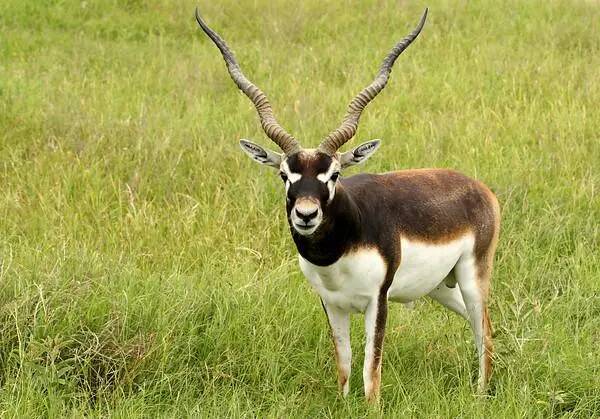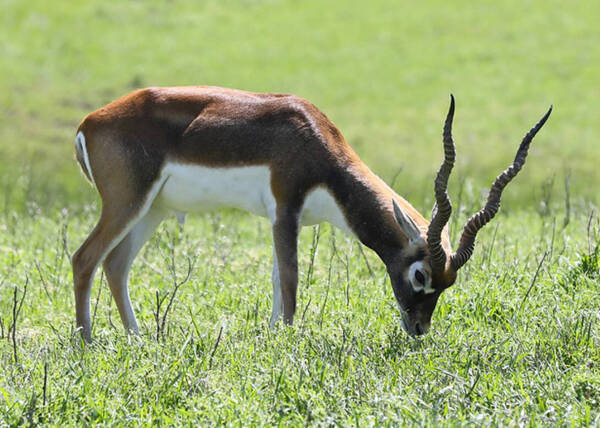Antilope cervicapra
IUCN
LCBasic Information
Scientific classification
- name:Antilope cervicapra
- Scientific Name:Antilope cervicapra
- Outline:Ungulata
- Family:Artiodactyla Bovidae Hirundo
Vital signs
- length:About 120 cm
- Weight:31-45kg
- lifetime:About 12 years
Feature
Possessing a pair of slender, straight, curved, spirally growing black horns
Distribution and Habitat
Existing (resident): India and Nepal.
Extinct: Bangladesh and Pakistan.
Introduced (resident): Argentina and United States.
The blackbuck was once distributed throughout almost the entire Indian subcontinent south of the Himalayas. Their range decreased during the 20th century, and they are extinct in Bangladesh and Pakistan, and still exist in some areas of Nepal. The species has been introduced to the United States (Texas) and Argentina.
The blackbuck inhabits open grasslands, dry thorn scrub, scrub and secondary woodland, and the edges of agricultural fields, usually foraging in the fields. The blackbuck requires water every day, which will limit their activities to areas with available surface water for most of the year. They are primarily grazing animals, but will wander and migrate when grass is scarce and they are forced to rely more on fallen leaves, flowers and fruits. They are mainly sedentary, but may move longer distances in the summer in search of water and for
Appearance
The blackbuck is slender, with a head-body length of about 120 cm and a shoulder height of about 73.7-83.8 cm. Males are larger than females. Adult males weigh between 34-45 kg; females weigh 31-39 kg. The tail is short. The abdomen, the area around the eyes and the inside of the legs are white. The color of the head and back of the males and females is different. The back and the outside of the limbs of females and young deer are light yellow-brown, and the underparts are white, and the two colors are sharply separated by a distinct lighter side band. The back, sides of the neck and front of the male deer are dark brown, and with age, they become almost black, only the nape remains tan or reddish brown, and the pale side band disappears. Males have V-shaped long horns that are spiraled, with a length of 45.6–68.5 cm and a maximum length of 71 cm. The horns are cylindrical and divergent, spiraling and looping, and generally twisting 3-5 times. Females are usually hornless.
Details
Antilope cervicapra, also known as Blackbuck in English, has two subspecies.

Antilope cervicapra is sensitive, alert by nature, good at running and continuous jumping, and is the most agile of the antelopes. It is a gregarious animal, but does not mix with other animals. It lives in open plains and savannas.
The blackbuck is a gregarious and social animal, with herds generally consisting of 5-50 individuals. Each herd consists of only one adult male and a few adult females and their offspring. In the cool season, they tend to be diurnal. In the hot season, they are active in the early morning and evening, and rest in the shade of trees at other times. They are very shy and wary by nature. Their sense of smell and hearing are not highly developed, and they rely mainly on their vision to detect danger. When in danger, one animal will leap into the air, followed shortly by the rest of the herd. These animals have great speed and endurance; when in danger, they can run for a distance of about 24 kilometers at a speed of 40 kilometers per hour. They usually remain silent, but sometimes females will make a hissing sound to warn the herd of impending danger.
The blackbuck avoids forested areas. They need water daily and may travel long distances in summer to find water and forage. They feed on short grasses and a variety of cultivated cereals. They feed mainly on herbs, but occasionally on leaves. They feed on acacia trees in the Cholistan Desert. In Velavadar National Park, they have been observed feeding on pods of Prosopis juliflora when forage is seasonally scarce.

The Indian gazelle can mate all year round, with the active estrus period occurring in March-April and August-October. During the estrus period, adult males mark territories by regularly depositing feces in specific places. During this time, males are extremely aggressive and drive all other males out of their territories through guttural grunts and occasional fights. The gestation period of females is about 6 months and in most cases only one calf is born per litter. The young blackbuck can run soon after birth. The longest life span recorded is 16 years and the average is 12 years.
The skin of Lord Krishna (Krishna Mrugam) plays an important role in Hinduism and it is customary for Brahman boys to wear a raw hide that has not been tanned after performing the "Sacred Thread Ceremony" (Upanayanam Samskara). According to Hindu mythology, the blackbuck or Krishna is believed to be the medium of the moon god "Chandrama". According to the "Garuda Purana" in Hindu mythology, "Krishna" brings prosperity to the areas where people live.

It is speculated that the number of black antelopes may have reached 4 million a few centuries ago, but in 1947 it was estimated to be only 80,000. Populations in India have increased from an estimated 22,000–24,000 in the 1970s to an estimated 50,000 (approximately 35,000 mature individuals) by 2000, with the highest numbers in Rajasthan, Punjab, Madhya Pradesh, Maharashtra, and Gujarat (Rahmani 2001). Nepal has approximately 200 individuals (Bashistha et al. 2012). Introduced species in Argentina and the United States may number up to 8,600 and 35,000, respectively (Mallon and Kingswood 2001). As of 2016, reliable population estimates of the species size are unavailable because no systematic censuses have been conducted. However, they remain widespread in many locations. The species has adapted to the edges of agricultural land, and there is some evidence that clearing of scrub and woodland can benefit it by creating suitable habitat. In some areas, the species has increased so rapidly that the blackbuck has become an agricultural pest, although not yet to the size of the greater bluebuck.
The blackbuck is fully protected by law in India. The species lives in many sanctuaries, including the Velavadar Blackbuck Sanctuary in Gujarat and the Gujarat and Point Calimere Wildlife Sanctuary in the southernmost part of India.
Listed in the IUCN Red List of Threatened Species 2016 ver 3.1 - Least Concern (LC).
Listed in the CITES Appendix III of the Washington Convention on International Trade in Endangered Species.
Protect wild animals and stop eating game.
Maintaining ecological balance is everyone's responsibility!








